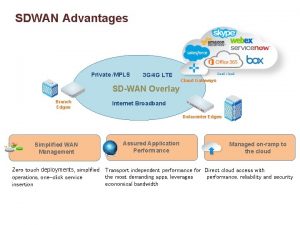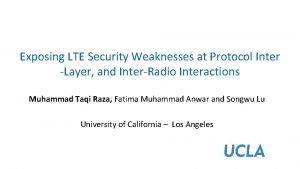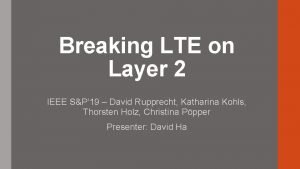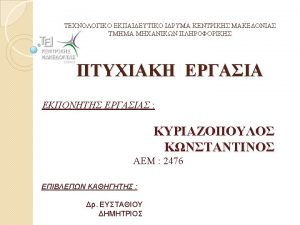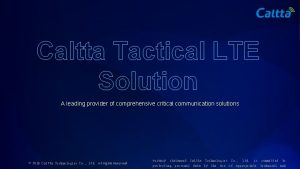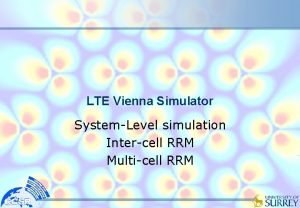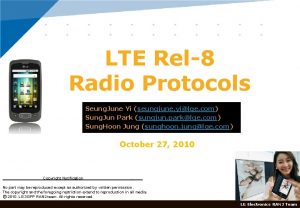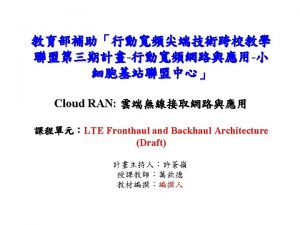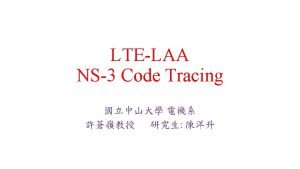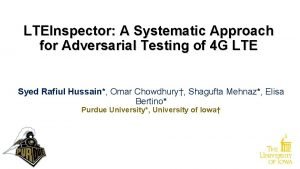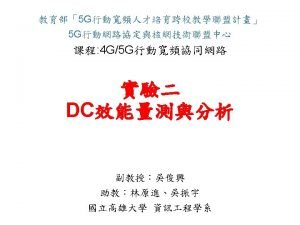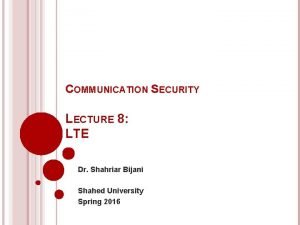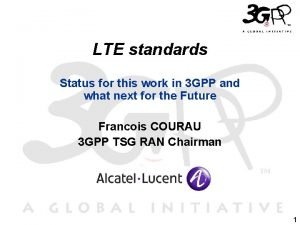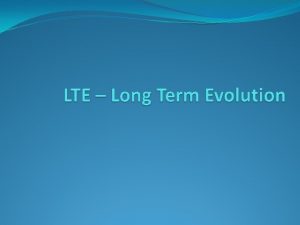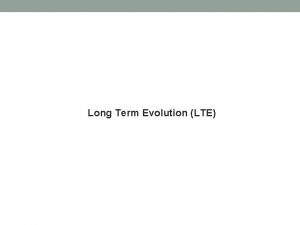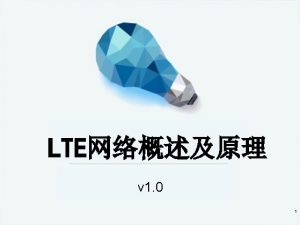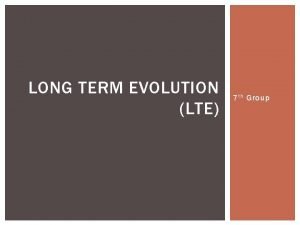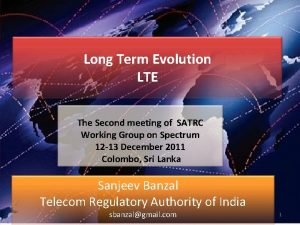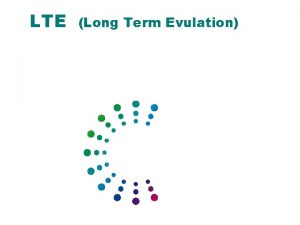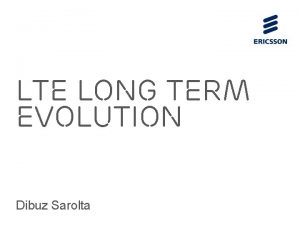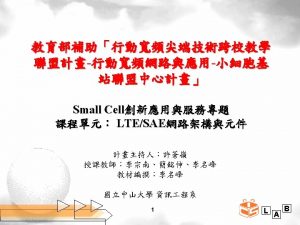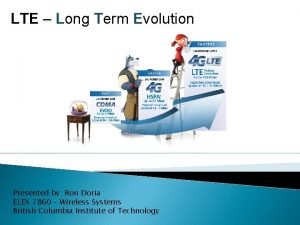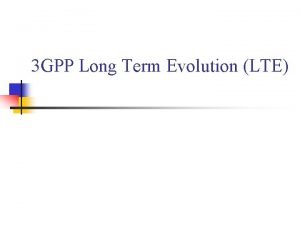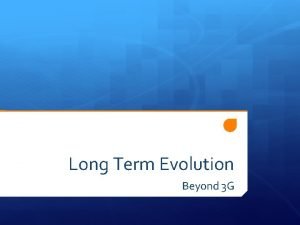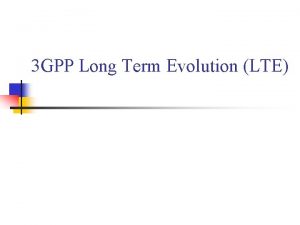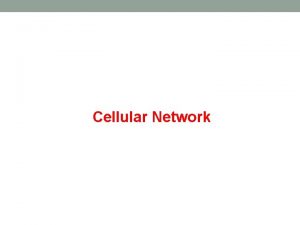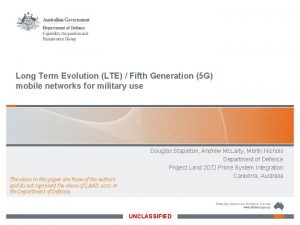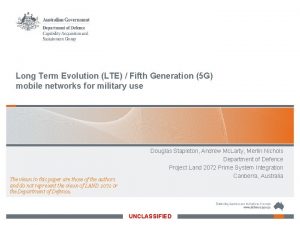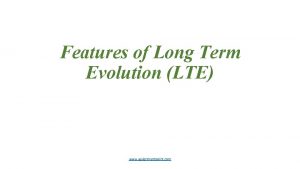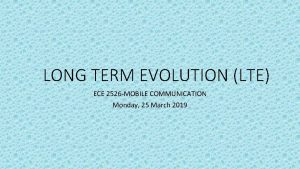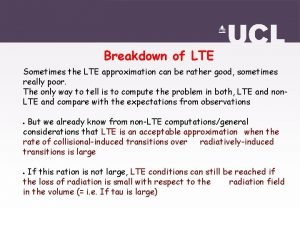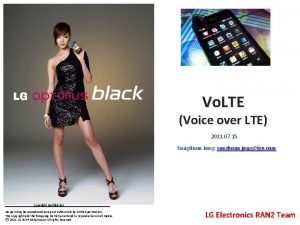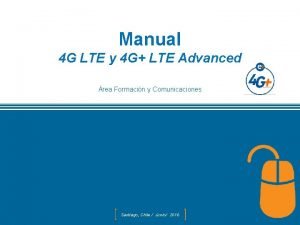Long Term Evolution LTE Long Term Evolution Advanced





























- Slides: 29

Long Term Evolution (LTE) Long Term Evolution – Advanced (LTE-A) Cont.





LTE frequency bands

UMTS Architecture

LTE Architecture

LTE vs UMTS • Functional changes compared to the current UMTS architecture

LTE Transmission Techniques • LTE employs Orthogonal Frequency Division Multiple Access (OFDMA) for downlink data transmission and Single Carrier FDMA (SCFDMA) for uplink transmission

LTE-Downlink (OFDM) • Improved spectral efficiency • Reduce ISI effect by multipath • Against frequency selective fading



FDM vs. OFDM 14

OFDM pros and cons Pros • Spectral efficiency • Robust against narrow-band co-channel interference • Higher throughput in the same frequency band (more subcarriers) Cons • It is more sensitive to carrier frequency offsets • More energy requirements due to high peak-to-average power ratio (PAPR)

SC/OFDMA

OFDMA allocation

OFDMA allocation

OFDMA/TDD structure

OFDMA/TDD structure

OFDMA/TDD structure

Generic Frame Structure

Resource Grid One downlink slot, Tslot 6 or 7 OFDM symbols Resource block : Transmission BW Resource element 12 subcarriers : l=0 l=6 • 6 or 7 OFDM symbols in 1 slot • Subcarrier spacing = 15 k. Hz • Block of 12 SCs in 1 slot = 1 RB – 0. 5 ms x 180 k. Hz – Smallest unit of allocation


• BPSK (Binary Phase Shift Keying) = 2 phase shifts, 1 amplitude level, 1 bit/symbol • QPSK (Quadrature Phase Shift Keying) = 4 phase shifts, 1 amplitude level, 2 bits/symbol • QAM-16 = 4 phase shifts, 4 amplitude levels, 4 bits/symbol • QAM-64 = 4 phase shifts, 16 amplitude levels, 6 bits/symbol QPSK QAM-16 QAM-64


Long Term Evolution Advanced (LTEA)


LTE-A main features Support of Wider Bandwidth(Carrier Aggregation) • Use of multiple component carriers(CC) to extend bandwidth up to 100 MHz • Common physical layer parameters between component carrier and LTE Rel-8 carrier è Improvement of peak data rate, backward compatibility with LTE Rel-8 Advanced MIMO techniques • • • è Extension to up to 8 -layer transmission in downlink Introduction of single-user MIMO up to 4 -layer transmission in uplink Enhancements of multi-user MIMO Improvement of peak data rate and capacity Heterogeneous network and e. ICIC (enhanced Inter-Cell Interference Coordination) • Interference coordination for overlaid deployment of cells with different Tx power è Improvement of cell-edge throughput and coverage Relay • Supports radio backhaul and creates a separate cell and appear as Rel. 8 LTE e. NB to Rel. 8 LTE UEs è Improvement of coverage and flexibility of service area extension Coordinated Multi-Point transmission and reception (Co. MP) • Support of multi-cell transmission and reception è Improvement of cell-edge throughput and coverage 100 MHz f CC
 Orthogonal frequency division multiplexing
Orthogonal frequency division multiplexing Long medium and short term planning in primary schools
Long medium and short term planning in primary schools Long term memory vs short term memory
Long term memory vs short term memory Example of short term human resources
Example of short term human resources Difference between long term and short term liabilities
Difference between long term and short term liabilities Long-term liabilities examples
Long-term liabilities examples Short term goals
Short term goals Short term financial management
Short term financial management Short short short long long long short short short
Short short short long long long short short short Once upon a time there lived a man
Once upon a time there lived a man Mpls over lte
Mpls over lte Lte handover events
Lte handover events Transmit diversity in lte
Transmit diversity in lte Paging in lte
Paging in lte Frame structure in lte
Frame structure in lte Breaking lte on layer two
Breaking lte on layer two Attach procedure
Attach procedure Lte τεστ προσομοιωσης
Lte τεστ προσομοιωσης Vo ltez
Vo ltez L
L Tactical lte
Tactical lte Congress of vienna simulation
Congress of vienna simulation Lte nas procedures
Lte nas procedures C-ran
C-ran Lte full duplex
Lte full duplex Quncovered
Quncovered V lte symbol on phone
V lte symbol on phone Gpp lte means
Gpp lte means 172 0 0 1
172 0 0 1 Gpp lte meaning
Gpp lte meaning










